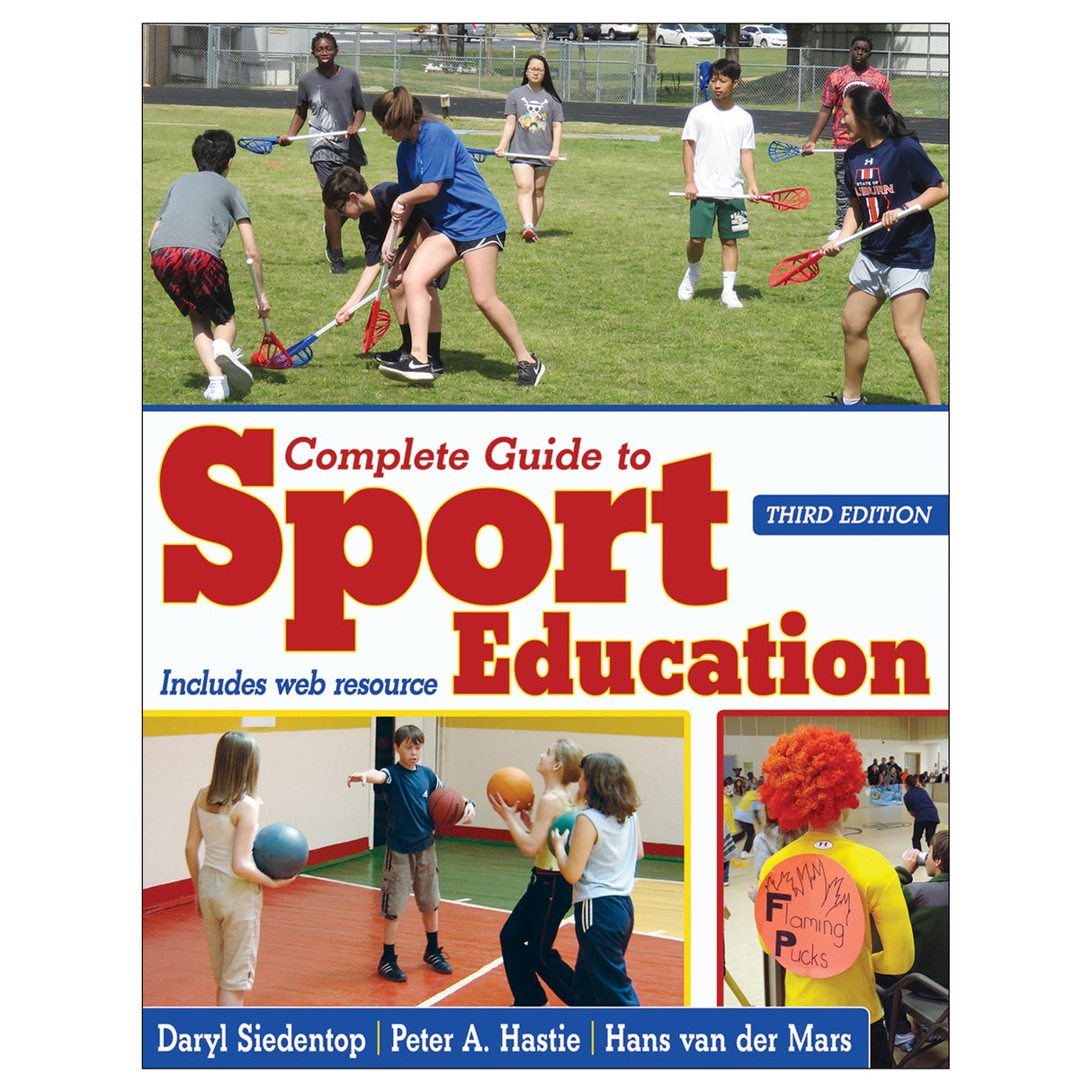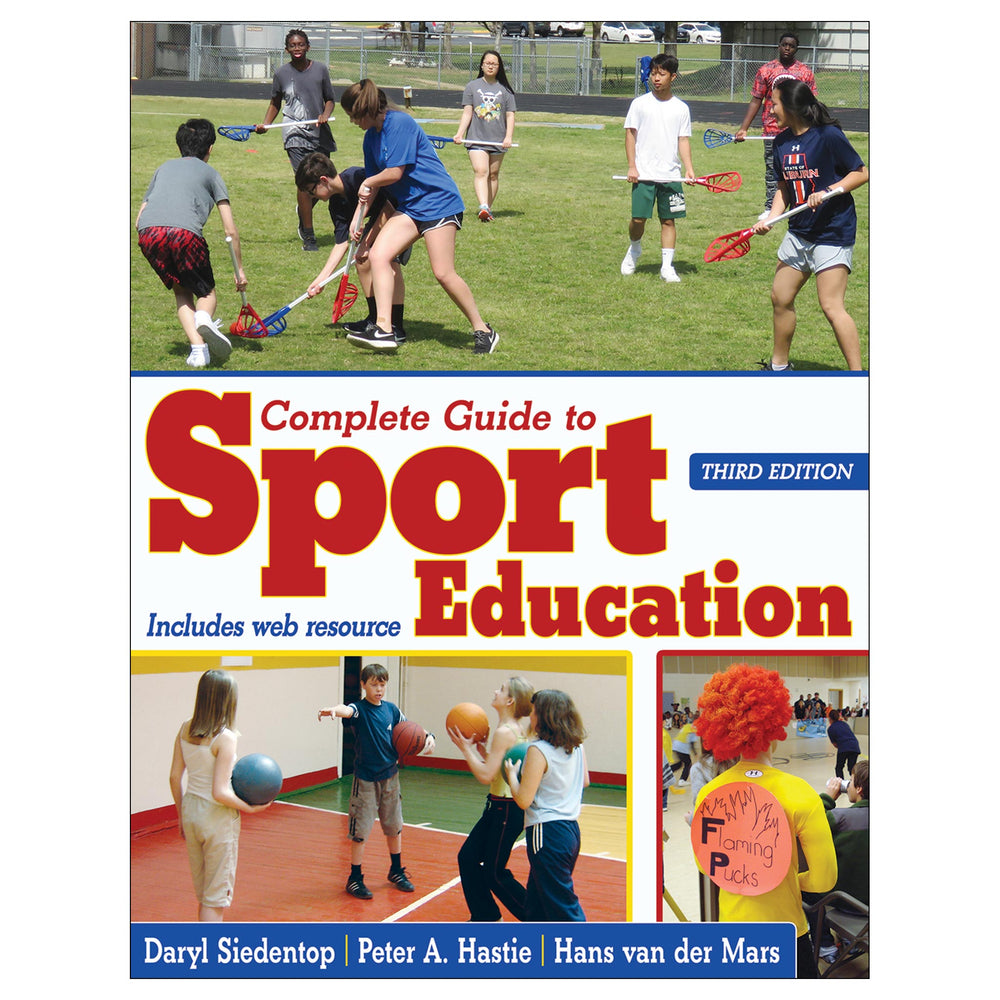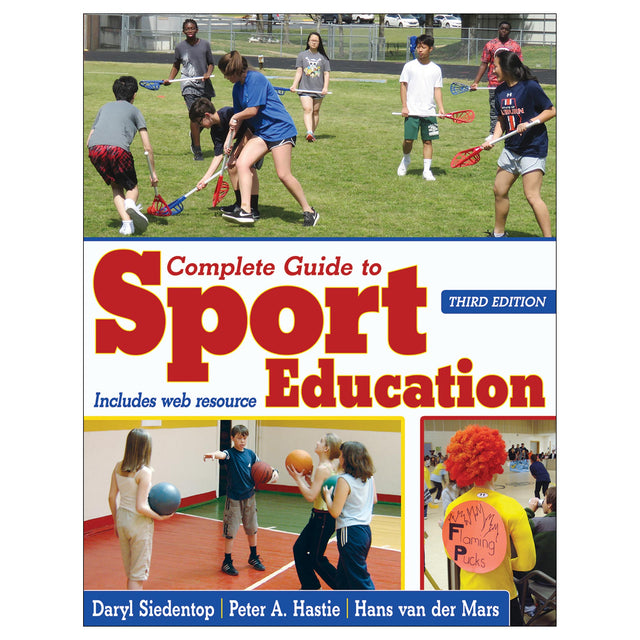Ebook With Online Resource
Complete Guide to Sport Education 3rd Edition epub With Web Resource
$75.95 CAD
Unit price
/
Unavailable
Ebook With Online Resource
$75.95 CAD
$75.95 CAD
Access Duration: 10 Years
Ebook With Online Resource
Complete Guide to Sport Education, Third Edition, offers a thoroughly updated version of the evidence-based curriculum and instruction model pioneered by Daryl Siedentop, universally acknowledged as the Father of Sport Education.
Lead author Siedentop first articulated his Sport Education model back in the late 1970s; it has evolved ever since and has been expressed through three editions of this book. This third edition is backed by substantial research that supports the idea that Sport Education is a valuable and motivating approach to delivering quality physical education experiences for students from the early elementary grades through the university years.
New and Revised Material
Complete Guide to Sport Education, Third Edition, offers readers a significant amount of revised and new material, including enhanced guidance for Sport Education programming across a year. Also noteworthy is the updated alignment of Sport Education’s goals and objectives with the SHAPE America standards and the national learning objectives from other countries. In addition, the text provides six brand-new chapters on the following topics:
Complete Guide to Sport Education represents a departure from traditional curriculum and instruction (C&I) models because it takes an effective student-centered approach, providing students with opportunities to take ownership and responsibility for various aspects of their class experiences. This approach better prepares students to be lifelong participants in healthy physical activity and sport—and to be more engaged in class.
The text targets more in-depth and authentic learning experiences than most C&I models, giving students time to develop the skills they need and to learn to fulfill the team roles required for successful seasons. This latest edition introduces new readers to the idea of Sport Education and gives previous users of the model some fresh ways to expand their seasons and make them even more engaging and attractive to their students.
Updated Ancillaries
Complete Guide to Sport Education comes with several useful and updated ancillaries:
This popular text, whose first edition was published in 1994, is very affordable compared to similar texts. But the greatest benefit is the enduring quality of an evidence-based, student-centered text that has proven to be of high value to instructors and students alike. Students develop sport skills, grow in leadership and responsibility, and learn about the nonplaying roles of the sport experience.
Lead author Siedentop first articulated his Sport Education model back in the late 1970s; it has evolved ever since and has been expressed through three editions of this book. This third edition is backed by substantial research that supports the idea that Sport Education is a valuable and motivating approach to delivering quality physical education experiences for students from the early elementary grades through the university years.
New and Revised Material
Complete Guide to Sport Education, Third Edition, offers readers a significant amount of revised and new material, including enhanced guidance for Sport Education programming across a year. Also noteworthy is the updated alignment of Sport Education’s goals and objectives with the SHAPE America standards and the national learning objectives from other countries. In addition, the text provides six brand-new chapters on the following topics:
- Including students with special needs
- Implementing Sport Education beyond physical education (e.g., school-based after-school programs, intramurals, community-based programs, and university basic instruction programs)
- Evidence-based research on Sport Education
- Developing effective program-level policies and procedures
- Managing equipment, facilities, and supplies
- Sport Education’s link with international objectives
Complete Guide to Sport Education represents a departure from traditional curriculum and instruction (C&I) models because it takes an effective student-centered approach, providing students with opportunities to take ownership and responsibility for various aspects of their class experiences. This approach better prepares students to be lifelong participants in healthy physical activity and sport—and to be more engaged in class.
The text targets more in-depth and authentic learning experiences than most C&I models, giving students time to develop the skills they need and to learn to fulfill the team roles required for successful seasons. This latest edition introduces new readers to the idea of Sport Education and gives previous users of the model some fresh ways to expand their seasons and make them even more engaging and attractive to their students.
Updated Ancillaries
Complete Guide to Sport Education comes with several useful and updated ancillaries:
- A web resource that provides a wealth of examples to support the book content; this resource includes forms, charts, assessments, and other tools
- A test package that houses 447 multiple-choice and short-answer questions
- A presentation package with 225 slides outlining the book’s content, including select tables and illustrations from the book
- An instructor guide that includes course syllabus templates for instructors of undergraduate and graduate students, and provides core course assignments, optional course assignments, graduate student course assignments, and signature assignments
This popular text, whose first edition was published in 1994, is very affordable compared to similar texts. But the greatest benefit is the enduring quality of an evidence-based, student-centered text that has proven to be of high value to instructors and students alike. Students develop sport skills, grow in leadership and responsibility, and learn about the nonplaying roles of the sport experience.
Audience
Undergraduate text for curriculum and teaching methods courses. Resource for physical education teachers as well as community recreational sport coaches and directors. Part I. The What and Why of Sport Education
Chapter 1. Key Features of the Sport Education Model
What Sport Education Looks Like
The Sport in Sport Education
How Sport Education Differs From Youth or Interscholastic Sport
The Goal of Sport Education
The Nature of Competition in Sport Education
Getting Started With Sport Education
Chapter 2. Curriculum and Instruction Foundations of Sport Education
How Sport Education Fits With Current Educational Thought
The Curricular Role of the Teacher in Sport Education
The Instructional Role of the Teacher in Sport Education
Summary
Chapter 3. Why Sport Education in Today’s Context
Sport as a Form of Play
The Evolution and Dominance of Sport
Problems and Critical Issues in Sport
Why Sport Should Be Central in School Physical Education
Technology and Developing Play Behavior
Summary
Chapter 4. Identifying and Selecting Season Outcomes
First Steps in Season Design
Selecting Season Outcomes
Sport Education’s Competence Objectives
Sport Education’s Literacy Objectives
Sport Education’s Enthusiasm Objectives
Summary
Chapter 5. Instructional Alignment as the Road Map to Quality Season Experiences
Alignment Across Levels
Season-Level Instructional Alignment
Lesson-Level Instructional Alignment
Additional Considerations for Establishing Instructional Alignment
Identifying Weak or Absent Instructional Alignment
Summary
Chapter 6. Promoting Physical Activity Beyond Physical Education
Comprehensive Physical Activity Programs in Schools
The National Focus on Promoting Physical Activity
Physical Activity Beyond Physical Education
Sport Education in Settings Other Than Physical Education and Schools
Summary
Part II. The How of Sport Education
Chapter 7. Modifying Games and Activities
Key Strategies for Modifying Games
Game Modifications: Event and Performance Sports
Game Modifications: Target Games
Game Modifications: Wall and Net Court Games
Game Modifications: Striking and Fielding Games
Game Modifications: Invasion Games
Student-Designed Modifications
Modifications to Include Students With Disabilities
Graded Competition
Summary
Chapter 8. Designing Competition Formats
Progressive Competition
Event Model
Setting Up a League Scoring System
Summary
Chapter 9. Selecting Teams and Roles
Deciding on the Number of Teams and Team Size
Selecting Students for Teams
Placing Students Into Teams
Student Roles
Important Considerations When Using Roles
Summary
Chapter 10. Teaching Protocols and Building Fair Play
Class Entry and First Activity
From Practice to Games
End of Games
Class Closure
Developing Positive Behavior Within a Culture of Fair Play
Strategies for Teaching Fair Play and Responsibility
Summary
Chapter 11. Developing Competent Players
The Teacher: Early Lessons
The Student Coach: Early Lessons
The Teacher: Early Independent Team Practices
The Student Coach: Early Independent Team Practices
The Teacher: Later Lessons
The Student Coach: Later Lessons
Summary
Chapter 12. Learning to Officiate, Keep Score, and Assess Fair Play
Developing Quality Officials
Practicing Duty Roles
Assessing Fair Play
Summary
Chapter 13. Making Sport Education Festive
Teams
Team Portfolios
Awards
Culminating Events
Developing Culminating Events
Summary
Chapter 14. Meaningful Inclusion of Students With Special Needs
Access to Education for Students With Disabilities
The Use of IEPs and the Role That Physical Educators Play
The Role of Paraeducators
Knowing the Disabilities
Facilitating an Inclusive Sport Education Setting
Behavior Management Considerations
Meaningful Participation in Sport Education for Students With Disabilities
The Role of Typically Developing Peers Within Sport Education
Adapted Sport
Summary
Chapter 15. Promoting Student Voice and Choice
Sport Board
A Sport Education Season Developed by Committees
A Sport Education Season Created Exclusively by Students
The Teacher’s Role in Creating Autonomy-Supportive Environments
Summary
Part III. Key Program Design Considerations
Chapter 16. Sport Education’s Link With U.S. Content Standards
How Sport Education’s Objectives Link With U.S. Content Standards
Standard 1: Demonstrates Competency in a Variety of Motor Skills and Movement Patterns
Standard 2: Applies Knowledge of Concepts, Principles, Strategies, and Tactics Related to Movement and Performance
Standard 3: Demonstrates the Knowledge and Skills to Achieve and Maintain a Health-Enhancing Level of Physical Activity and Fitness
Standard 4: Exhibits Responsible Personal and Social Behavior That Respects Self and Others
Standard 5: Recognizes the Value of Physical Activity for Health, Enjoyment, Challenge, Self-Expression, and Social Interaction
Sport Education’s Objectives and Grade-Level Outcomes
How Important Is the Link Between Content Standards and Sport Education’s Objectives?
Summary
Chapter 17. Sport Education’s Link With International Outcomes
Australia
England
Ireland
New Zealand
Portugal
Scotland
Spain
Summary
Chapter 18. Building Program Credibility and Legitimacy Through Assessment
Assessment Defined
Assessment in Sport Education
Infusing Authentic and Workable Assessments Into Seasons
Types of Assessment Tools
Assessing In-Class Physical Activity
Assessing Out-of-Class Physical Activity
Making a Case for Your Program
Summary
Chapter 19. Organizing a Sport Education-Themed Physical Education Program
Developing a Program Mission Statement
Establishing a Distinct Program Theme
Selecting and Organizing the Program Content
Developing a Yearly Block Plan
Summary
Chapter 20. Managing a Sport Education Program
Developing Program Policies and Procedures
Management of Equipment, Facilities, and Supplies
Program Budgeting
Supervision, Safety, and Liability
Summary
Chapter 21. Integrating Classroom Content With Sport Education
The Concept of Parallel Design
A School-Wide Parallel Sport Education Season
An Olympic Values Curriculum
Using Sport Education Resources to Enhance Classroom Learning
Summary
Chapter 1. Key Features of the Sport Education Model
What Sport Education Looks Like
The Sport in Sport Education
How Sport Education Differs From Youth or Interscholastic Sport
The Goal of Sport Education
The Nature of Competition in Sport Education
Getting Started With Sport Education
Chapter 2. Curriculum and Instruction Foundations of Sport Education
How Sport Education Fits With Current Educational Thought
The Curricular Role of the Teacher in Sport Education
The Instructional Role of the Teacher in Sport Education
Summary
Chapter 3. Why Sport Education in Today’s Context
Sport as a Form of Play
The Evolution and Dominance of Sport
Problems and Critical Issues in Sport
Why Sport Should Be Central in School Physical Education
Technology and Developing Play Behavior
Summary
Chapter 4. Identifying and Selecting Season Outcomes
First Steps in Season Design
Selecting Season Outcomes
Sport Education’s Competence Objectives
Sport Education’s Literacy Objectives
Sport Education’s Enthusiasm Objectives
Summary
Chapter 5. Instructional Alignment as the Road Map to Quality Season Experiences
Alignment Across Levels
Season-Level Instructional Alignment
Lesson-Level Instructional Alignment
Additional Considerations for Establishing Instructional Alignment
Identifying Weak or Absent Instructional Alignment
Summary
Chapter 6. Promoting Physical Activity Beyond Physical Education
Comprehensive Physical Activity Programs in Schools
The National Focus on Promoting Physical Activity
Physical Activity Beyond Physical Education
Sport Education in Settings Other Than Physical Education and Schools
Summary
Part II. The How of Sport Education
Chapter 7. Modifying Games and Activities
Key Strategies for Modifying Games
Game Modifications: Event and Performance Sports
Game Modifications: Target Games
Game Modifications: Wall and Net Court Games
Game Modifications: Striking and Fielding Games
Game Modifications: Invasion Games
Student-Designed Modifications
Modifications to Include Students With Disabilities
Graded Competition
Summary
Chapter 8. Designing Competition Formats
Progressive Competition
Event Model
Setting Up a League Scoring System
Summary
Chapter 9. Selecting Teams and Roles
Deciding on the Number of Teams and Team Size
Selecting Students for Teams
Placing Students Into Teams
Student Roles
Important Considerations When Using Roles
Summary
Chapter 10. Teaching Protocols and Building Fair Play
Class Entry and First Activity
From Practice to Games
End of Games
Class Closure
Developing Positive Behavior Within a Culture of Fair Play
Strategies for Teaching Fair Play and Responsibility
Summary
Chapter 11. Developing Competent Players
The Teacher: Early Lessons
The Student Coach: Early Lessons
The Teacher: Early Independent Team Practices
The Student Coach: Early Independent Team Practices
The Teacher: Later Lessons
The Student Coach: Later Lessons
Summary
Chapter 12. Learning to Officiate, Keep Score, and Assess Fair Play
Developing Quality Officials
Practicing Duty Roles
Assessing Fair Play
Summary
Chapter 13. Making Sport Education Festive
Teams
Team Portfolios
Awards
Culminating Events
Developing Culminating Events
Summary
Chapter 14. Meaningful Inclusion of Students With Special Needs
Access to Education for Students With Disabilities
The Use of IEPs and the Role That Physical Educators Play
The Role of Paraeducators
Knowing the Disabilities
Facilitating an Inclusive Sport Education Setting
Behavior Management Considerations
Meaningful Participation in Sport Education for Students With Disabilities
The Role of Typically Developing Peers Within Sport Education
Adapted Sport
Summary
Chapter 15. Promoting Student Voice and Choice
Sport Board
A Sport Education Season Developed by Committees
A Sport Education Season Created Exclusively by Students
The Teacher’s Role in Creating Autonomy-Supportive Environments
Summary
Part III. Key Program Design Considerations
Chapter 16. Sport Education’s Link With U.S. Content Standards
How Sport Education’s Objectives Link With U.S. Content Standards
Standard 1: Demonstrates Competency in a Variety of Motor Skills and Movement Patterns
Standard 2: Applies Knowledge of Concepts, Principles, Strategies, and Tactics Related to Movement and Performance
Standard 3: Demonstrates the Knowledge and Skills to Achieve and Maintain a Health-Enhancing Level of Physical Activity and Fitness
Standard 4: Exhibits Responsible Personal and Social Behavior That Respects Self and Others
Standard 5: Recognizes the Value of Physical Activity for Health, Enjoyment, Challenge, Self-Expression, and Social Interaction
Sport Education’s Objectives and Grade-Level Outcomes
How Important Is the Link Between Content Standards and Sport Education’s Objectives?
Summary
Chapter 17. Sport Education’s Link With International Outcomes
Australia
England
Ireland
New Zealand
Portugal
Scotland
Spain
Summary
Chapter 18. Building Program Credibility and Legitimacy Through Assessment
Assessment Defined
Assessment in Sport Education
Infusing Authentic and Workable Assessments Into Seasons
Types of Assessment Tools
Assessing In-Class Physical Activity
Assessing Out-of-Class Physical Activity
Making a Case for Your Program
Summary
Chapter 19. Organizing a Sport Education-Themed Physical Education Program
Developing a Program Mission Statement
Establishing a Distinct Program Theme
Selecting and Organizing the Program Content
Developing a Yearly Block Plan
Summary
Chapter 20. Managing a Sport Education Program
Developing Program Policies and Procedures
Management of Equipment, Facilities, and Supplies
Program Budgeting
Supervision, Safety, and Liability
Summary
Chapter 21. Integrating Classroom Content With Sport Education
The Concept of Parallel Design
A School-Wide Parallel Sport Education Season
An Olympic Values Curriculum
Using Sport Education Resources to Enhance Classroom Learning
Summary
Developing Positive Behavior Within a Culture of Fair Play
Establishing a Distinct Program Theme
Physical Activity Beyond Physical Education
Establishing a Distinct Program Theme
Physical Activity Beyond Physical Education
All ancillaries are free to adopting instructors and available online.
Test Package. Houses 447 multiple-choice and short-answer questions.
Instructor Guide. Includes course syllabus templates for undergraduate and graduate students and provides core course assignments, graduate student course assignments, and a signature assignment.
Presentation Package. Features 225 slides outlining the book’s content, including select tables and illustrations from the book.
Web Resource. Provides a wealth of examples to support the book content; this resource includes forms, charts, assessments, and other tools.
Test Package. Houses 447 multiple-choice and short-answer questions.
Instructor Guide. Includes course syllabus templates for undergraduate and graduate students and provides core course assignments, graduate student course assignments, and a signature assignment.
Presentation Package. Features 225 slides outlining the book’s content, including select tables and illustrations from the book.
Web Resource. Provides a wealth of examples to support the book content; this resource includes forms, charts, assessments, and other tools.





